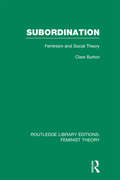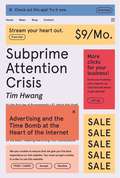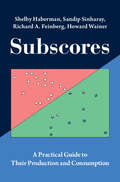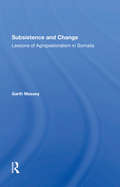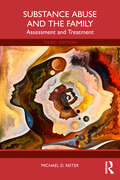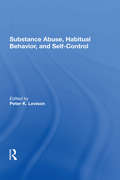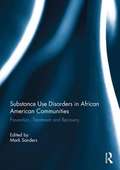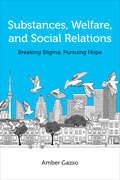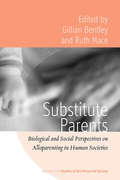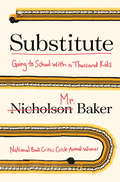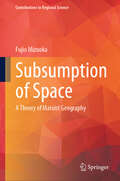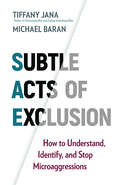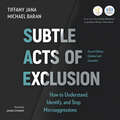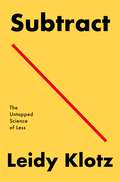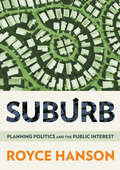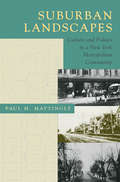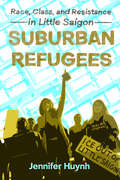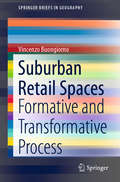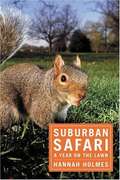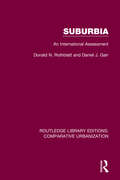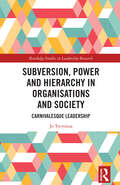- Table View
- List View
Subordination: Feminism and Social Theory (Routledge Library Editions: Feminist Theory)
by Clare BurtonSubordination presents a survey of some of the most important ideas developed within feminism since the 1970s. Among the central themes addressed are: the origins of women’s subordination; the private/public split; the nature and the role of domestic labour; the impact of psychoanalysis on feminist theory; the relationship between the State and women’s subordination. One of the book’s purposes is to draw together strands of thought and debate often kept separate. Throughout, the major theoretical developments in Britain, the United States and Australia are reviewed within a comparative perspective. Consistently, the focus of attention is on how, and how far, theorists in these countries have been able to point to ways of explaining the changing but enduring nature of sexual inequalities.
Subprime Attention Crisis: Advertising and the Time Bomb at the Heart of the Internet (FSG Originals x Logic)
by Tim HwangFrom FSGO x Logic: a revealing examination of digital advertising and the internet's precarious foundationIn Subprime Attention Crisis, Tim Hwang investigates the way big tech financializes attention. In the process, he shows us how digital advertising—the beating heart of the internet—is at risk of collapsing, and that its potential demise bears an uncanny resemblance to the housing crisis of 2008. From the unreliability of advertising numbers and the unregulated automation of advertising bidding wars, to the simple fact that online ads mostly fail to work, Hwang demonstrates that while consumers’ attention has never been more prized, the true value of that attention itself—much like subprime mortgages—is wildly misrepresented. And if online advertising goes belly-up, the internet—and its free services—will suddenly be accessible only to those who can afford it. Deeply researched, convincing, and alarming, Subprime Attention Crisis will change the way you look at the internet, and its precarious future.FSG Originals × Logic dissects the way technology functions in everyday lives. The titans of Silicon Valley, for all their utopian imaginings, never really had our best interests at heart: recent threats to democracy, truth, privacy, and safety, as a result of tech’s reckless pursuit of progress, have shown as much. We present an alternate story, one that delights in capturing technology in all its contradictions and innovation, across borders and socioeconomic divisions, from history through the future, beyond platitudes and PR hype, and past doom and gloom. Our collaboration features four brief but provocative forays into the tech industry’s many worlds, and aspires to incite fresh conversations about technology focused on nuanced and accessible explorations of the emerging tools that reorganize and redefine life today.
Subscores: A Practical Guide to Their Production and Consumption
by Shelby Haberman Sandip Sinharay Richard A. Feinberg Howard WainerThis authoritative guide directs consumers and users of test scores on when and how to provide subscores and how to make informed decisions based on them. The book is designed to be accessible to practitioners and score users with varying levels of technical expertise, from executives of testing organizations and students who take tests to graduate students in educational measurement, psychometricians, and test developers. The theoretical background required to evaluate subscores and improve them are provided alongside examples of tests with subscores to illustrate their use and misuse. The first chapter covers the history of tests, subtests, scores, and subscores. Later chapters go into subscore reporting, evaluating and improving the quality of subscores, and alternatives to subscores when they are not appropriate. This thorough introduction to the existing research and best practices will be useful to graduate students, researchers, and practitioners.
Subsistence And Change: Lessons Of Agropastoralism In Somalia
by Garth MasseyFocusing on an agropastoral society of southcentral Somalia, this book explores the seeming incompatibility of subsistence agriculture and development goals. Based upon survey and ethnographic research carried out among the Rahanweyn, the study pays particular attention to economic activities, linking them with environmental factors as well as with history, culture, the division of labor and women's roles, family structure, demography, and herding and agriculture. How change can best be introduced into such a society is the central question of the book. The meaning of subsistence and its relationship to self-sufficiency and a survival threshold are examined within the context of an externally imposed market system. The implications of rapidly induced market involvement in a traditional society are looked at in light of data on a range of subsistence societies. The author argues for a redirection of development practices, making a case for the viability of a mixed agropastoral system that diverges little from the traditional subsistence patterns, and for peasant-centered development compatible with subsistence production, balancing national and international interests.
Substance Abuse and the Family: Assessment and Treatment
by Michael D. ReiterThis fully updated third edition of Substance Abuse and the Family demonstrates what it means to view addiction through a systems lens by considering biology and genetics, family relationships, and larger systems.Michael D. Reiter illustrates how to examine a person’s predilection to become addicted, their social environment around substance use, the functionality of their family, and various treatment options. Chapters are organized around two sections: assessment and treatment. The first section pays attention to how the family system organizes around substance use and abuse. Here family roles, culture, and other issues such as family violence and resilience are covered. Two chapters are also included on the neuroscience and genetics of addiction. There are also chapters on roles of family members in addicted families, using genograms, and working in a culturally sensitive way, with culture-specific consideration paid to Black, Hispanic and Latin American, Asian American, and Indigenous families. A separate chapter examines issues faced by both youth and adult children of alcoholics. The second half of the book explores what a systems orientation means in practice and goes over self-help groups for individuals and families. An overview of the major family therapy theories is included, which examines intergenerational, experiential, communication, strategic, systemic, and postmodern models. New to this edition is a chapter on trauma and stigma and its relationship to addictions and substance use and abuse. Each chapter has been updated with cutting-edge research and additional figures to enhance concepts, as well a case application to demonstrate and apply each chapter’s ideas.Intended for undergraduate and graduate students, as well as beginning practitioners, this text provides one of the most in-depth examinations on the topic available.
Substance Abuse, Habitual Behavior, And Self-control
by Peter K. LevisonThis collection of original essays by members of the National Academy of Sciences’ Committee on Substance Abuse and Habitual Behavior offers innovative perspectives on self-control over the use of habituating substances and related types of behavior. The authors review the powerful social-psychological influences of normative rules and interpersonal circumstances in developing individual capacities for self-control in, for example, the use of heroin. They also look at experimental contingencies under which animals engage in self-harming behavior; the induction of exaggerated consumption behavior, such as massive fluid drinking by laboratory rats; and studies of environmental and genetic influences on neurophysiological sensitivity to and preference for alcohol in laboratory mouse strains. The concluding chapter presents an unorthodox perspective on ways of self-governing the consumption of cigarettes and other substances, recognizing the peculiarities of the processes of human choice. In his introduction, volume editor Peter Levison contrasts the diverse approaches reflected in the book with the common-sense notion of self-control.
Substance Use Disorders in African American Communities: Prevention, Treatment and Recovery
by Mark SandersThis book is dedicated to the prevention, treatment, and recovery of African Americans with substance use disorders. African Americans are disproportionately represented in the addictions, criminal justice, and child welfare systems. It is clear that, when their culturally specific needs are not met, they are vulnerable to continuous relapse and the revolving door syndrome. It is an important contribution to the field of behavioral health, providing a much-needed treasure trove of important knowledge from specialists, including physicians, psychologists, educators, social workers, addictions counselors, public health specialists, researchers, the clergy, as well as individuals in recovery. This volume adds significantly to the knowledge base of practitioners and researchers whose work focuses on prevention, treatment, and recovery in African American communities.
Substances, Welfare, and Social Relations: Breaking Stigma, Pursuing Hope
by Amber GazsoSubstances, Welfare, and Social Relations uses intimate, complex portraits to tell the stories of people who have lived some part of their life course while using or recovering from using substances (such as alcohol or illicit or prescription drugs) and also being part of a family and experiencing poverties. Through these multifaceted stories, layered with a critical analysis of welfare policy, the book probes the deeply entrenched stigma of living with addiction and in low income. Amber Gazso’s work revolves around the three-principles idea that (1) addiction is part of everyday life; (2) if we believe that people are not their addictions, then stigmatizing addiction has no place in society; and (3) destigmatizing addiction and providing better, more imaginative programs and services invites and supports actionable hope. Reflecting on qualitative data, both narrative interviews and policy discourse, Substances, Welfare, and Social Relations illuminates how stigmas can be overturned through a collective praxis of hope.
Substitute Parents
by Ruth Mace Gillian BentleyFrom a comparative perspective, human life histories are unique and raising offspring is unusually costly: humans have relatively short birth intervals compared to other apes, childhood is long, mothers care simultaneously for many dependent children (other apes raise one offspring at a time), infant mortality is high in natural fertility/mortality populations, and human females have a long post-reproductive lifespan. These features conspire to make child raising very burdensome. Mothers frequently defray these costs with paternal help (not usual in other ape species), although this contribution is not always enough. Grandmothers, elder siblings, paid allocarers, or society as a whole, help to defray the costs of childcare, both in our evolutionary past and now. Studying offspring care in a various human societies, and other mammalian species, a wide range of specialists such as anthropologists, psychologists, animal behaviorists, evolutionary ecologists, economists and sociologists, have contributed to this volume, offering new insights into and a better understanding of one of the key areas of human society.
Substitute: Going to School With a Thousand Kids
by Nicholson Baker"May be the most revealing depiction of the American contemporary classroom that we have to date." --Garret Keizer, The New York Times Book Review Bestselling author Nicholson Baker, in pursuit of the realities of American public education, signed up as a substitute teacher in a Maine public school district.In 2014, after a brief orientation course and a few fingerprinting sessions, Nicholson Baker became an on-call substitute teacher in a Maine public school district. He awoke to the dispatcher's five-forty a.m. phone call and headed to one of several nearby schools; when he got there, he did his best to follow lesson plans and help his students get something done. What emerges from Baker's experience is a complex, often touching deconstruction of public schooling in America: children swamped with overdue assignments, overwhelmed by the marvels and distractions of social media and educational technology, and staff who weary themselves trying to teach in step with an often outmoded or overly ambitious standard curriculum. In Baker's hands, the inner life of the classroom is examined anew--mundane worksheets, recess time-outs, surprise nosebleeds, rebellions, griefs, jealousies, minor triumphs, kindergarten show-and-tell, daily lessons on everything from geology to metal tech to the Holocaust--as he and his pupils struggle to find ways to get through the day. Baker is one of the most inventive and remarkable writers of our time, and Substitute, filled with humor, honesty, and empathy, may be his most impressive work of nonfiction yet.From the Hardcover edition.
Substitute: Going to School With a Thousand Kids
by Nicholson Baker**A New York Times Bestseller**"May be the most revealing depiction of the American contemporary classroom that we have to date." --Garret Keizer, The New York Times Book Review Bestselling author Nicholson Baker, in pursuit of the realities of American public education, signed up as a substitute teacher in a Maine public school district.In 2014, after a brief orientation course and a few fingerprinting sessions, Nicholson Baker became an on-call substitute teacher in a Maine public school district. He awoke to the dispatcher's five-forty a.m. phone call and headed to one of several nearby schools; when he got there, he did his best to follow lesson plans and help his students get something done. What emerges from Baker's experience is a complex, often touching deconstruction of public schooling in America: children swamped with overdue assignments, overwhelmed by the marvels and distractions of social media and educational technology, and staff who weary themselves trying to teach in step with an often outmoded or overly ambitious standard curriculum. In Baker's hands, the inner life of the classroom is examined anew--mundane worksheets, recess time-outs, surprise nosebleeds, rebellions, griefs, jealousies, minor triumphs, kindergarten show-and-tell, daily lessons on everything from geology to metal tech to the Holocaust--as he and his pupils struggle to find ways to get through the day. Baker is one of the most inventive and remarkable writers of our time, and Substitute, filled with humor, honesty, and empathy, may be his most impressive work of nonfiction yet.From the Hardcover edition.
Subsumption of Space: A Theory of Marxist Geography (Contributions to Regional Science)
by Fujio MizuokaThis book takes a Marxist perspective to explore the dynamics of space. By employing dialectical materialist logic, it explains how a heterogeneous spatial configuration emerges through the dialectical process to transcend the contradiction generated by the subsumption (incorporation) of an sich pristine spaces into society, with a particular focus on the context of capitalism. The key concept here is 'subsumption', as presented by Marx in 'The Results of the Immediate Process of Production'. This book is first of its kind that thought-provokingly demonstrates the dialectical logic of the production of space through the application of Marxist logic of subsumption. It succinctly argues that heterogeneous spatial configurations are produced through the society's effort to transcend these contradictions, or the subsumption of space, which transforms pristine space subsumed into a one-point society in formal terms toward a heterogeneous spatial configuration, resulting in an und für sich produced space or space subsumed in real terms. The book also suggests the role of the produced space in potential utilization of space in social struggles. Based on this conceptual framework, this book discusses the built environment, the space embedded in people's minds, and the effects of the capitalist business cycle on space. Ultimately, it presents a compelling case for activists to harness the space produced in their social struggles.
Subtle Acts of Exclusion: How to Understand, Identify, and Stop Microaggressions
by Tiffany Jana Michael BaranThis practical, accessible, nonjudgmental handbook is the first to help individuals and organizations recognize and prevent microaggressions so that all employees can feel a sense of belonging in their workplace. Our workplaces and society are growing more diverse, but are we supporting inclusive cultures? While overt racism, sexism, ableism, and other forms of discrimination are relatively easy to spot, we cannot neglect the subtler everyday actions that normalize exclusion. Many have heard the term microaggression, but not everyone fully understands what they are or how to recognize them and stop them from happening. In this book, Tiffany Jana and Michael Baran offer a clearer, more accessible term, subtle acts of exclusion, or SAEs, to emphasize the purpose and effects of these actions. After all, people generally aren't trying to be aggressive—usually they're trying to say something nice, learn more about a person, be funny, or build closeness. But whether in the form of exaggerated stereotypes, backhanded compliments, unfounded assumptions, or objectification, SAE are damaging to our coworkers, friends, and acquaintances. Jana and Baran give simple and clear tools to identify and address such acts, offering scripts and action plans for everybody involved: the subject, initiator, and observer. Knowing how to have these conversations in an open-minded, honest way will help us build trust and create stronger workplaces and healthier, happier people and communities.
Subtle Acts of Exclusion: How to Understand, Identify, and Stop Microaggressions
by Tiffany Jana Michael BaranAn expanded edition of the first practical, nonjudgmental handbook for dealing with microaggressions, featuring examples, sample scripts, action plans, a new discussion and activity guide, and up-to-date suggestions for creating a culture of belonging in the workplace.Overt discrimination is relatively easy to spot. But the less obvious but more common actions that make people feel left out or stigmatized in our workplaces, commonly called microaggressions, can be hard to identify and even harder to deal with.The author use a clearer, more accurate term: subtle acts of exclusion (SAE). After all, people generally aren't trying to be aggressive-usually they're trying to say something nice, learn more about a person, or be funny. Bring accused of aggression shuts the conversation down, when you want to open it up. This book features examples, tools, sample scripts, and action plans to help readers prevent subtle acts of aggression from happening, or deal with them when they do. Updated throughout, this second edition features: A greatly expanded chapter on intentional acts of inclusion-actions for creating a sense of belonging. A discussion and activity guide ideal for book clubs and training sessions A new concluding chapter, Hope for HumanityWhether in the form of stereotypes, assumptions, backhanded compliments, or objectification, SAEs are damaging to our coworkers, friends, and acquaintances. This book is your friendly, accessible, non-judgemental guide to creating a welcoming workplace.
Subtract: The Untapped Science of Less
by Leidy KlotzBlending evidence across science and design, Subtract: The Untapped Science of Less offers a revolution in problem-solving: proving why we overlook subtraction, and how we can access its true potentialWe pile on “to-dos” but don’t consider “stop-doings.” We create incentives for good behavior, but don’t get rid of obstacles to it. We collect new-and-improved ideas, but don’t prune the outdated ones. Every day, across challenges big and small, we neglect a basic way to make things better: we don’t subtract.Leidy Klotz’s pioneering research shows why. Whether we’re building Lego models or cities, grilled-cheese sandwiches or strategic plans, our minds tend to add before taking away. Even when we do think of it, subtraction can be harder to pull off because an array of biological, cultural, and economic forces push us towards more. But we have a choice—our blind spot need not go on taking its toll on our cities, our institutions, and our minds. By diagnosing our neglect of subtraction, we can treat it. Subtract will change how you change your world. In these pages you’ll meet subtracting exemplars: design geniuses, Nobel Prize-winners, rock-stars, and everyday heroes, who have subtracted to dismantle racism, advance knowledge, heal the planet, and even tell better jokes. These and more guiding lights show how we can revolutionize not just our day-to-day lives, but our collective legacy. A paradigm shift of a book, Subtract shows us how to find more of the options we’ve been missing—and empowers us to pursue them.
Suburb: Planning Politics and the Public Interest
by Royce HansonLand-use policy is at the center of suburban political economies because everything has to happen somewhere but nothing happens by itself. In Suburb, Royce Hanson explores how well a century of strategic land-use decisions served the public interest in Montgomery County, Maryland, a suburb of Washington, D.C. Transformed from a rural hinterland into the home a million people and a half-million jobs, Montgomery County built a national reputation for innovation in land use policy—including inclusive zoning, linking zoning to master plans, preservation of farmland and open space, growth management, and transit-oriented development.A pervasive theme of Suburb involves the struggle for influence over land use policy between two virtual suburban republics. Developers, their business allies, and sympathetic officials sought a virtuous cycle of market-guided growth in which land was a commodity and residents were customers who voted with their feet. Homeowners, environmentalists, and their allies saw themselves as citizens and stakeholders with moral claims on the way development occurred and made their wishes known at the ballot box. In a book that will be of particular interest to planning practitioners, attorneys, builders, and civic activists, Hanson evaluates how well the development pattern produced by decades of planning decisions served the public interest.
Suburban Landscapes: Culture and Politics in a New York Metropolitan Community (Creating the North American Landscape)
by Paul H. MattinglyCertificate of Commendation from the American Association for State and Local HistoryMost Americans today live in the suburbs. Yet suburban voices remain largely unheard in sociological and cultural studies of these same communities. In Suburban Landscapes: Culture and Politics in a New York Metropolitan Community, Paul Mattingly provides a new model for understanding suburban development through his narrative history of Leonia, New Jersey, an early commuter suburb of New York City.Although Leonia is a relatively small suburb, a study of this kind has national significance because most of America's suburbs began as rural communities, with histories that predated the arrival of commuters and real estate developers. Examining the dynamics of community cultural formation, Mattingly contests the prevailing urban and suburban dichotomy. In doing so, he offers a respite from journalistic cliches and scholarly bias about the American suburb, providing instead an insightful, nuanced look at the integrative history of a region.Mattingly examines Leonia's politics and culture through three eras of growth and change (1859-94, 1894-1920, and 1920-60). A major part of Leonia's history, Mattingly reveals, was its role as an attractive community for artists and writers, many contributors to national magazines, who created a 'suburban' aesthetic. The work done by generations of Leonias' artists provides an important vantage and a wonderful set of tools for exploring evolving notions of suburban culture and landscape, which have broad implications and applications. Oral histories, census records, and the extensive work of Leonia's many artists and writers come together to trace not only the community's socially diverse history, but to show how residents viewed the growth and transformation of Leonia as well.
Suburban Refugees: Class and Resistance in Little Saigon
by Jennifer HuynhAmerica's suburbs are more diverse and more unequal than ever before. Focusing on Southern California's Little Saigon, a global suburb and the capital of "Vietnamese America," Jennifer Huynh shows how refugees and their children are enacting placemaking against forces of displacement such as financialized capital, exclusionary zoning, and the criminalization of migrants. This book raises crucial questions challenging suburban inequality and complicates our understanding of refugee resettlement—and, more broadly, the American dream.
Suburban Retail Spaces: Formative and Transformative Process (SpringerBriefs in Geography)
by Vincenzo BuongiornoThis book derives from observations of the contemporary built environment and its contradictions. The suburban retail spaces, specifically the suburban shopping mall, and the changes caused by them within urban organisms are the object of the investigation synthesized in the volume. The topic is very crucial for the development of the contemporary city. It constitutes at the same time a problem (large commercial structures' spread is 'destroying' traditional commercial urban fabrics) and an opportunity (shopping malls are the most vital parts of the new suburbs and can play the role of community nucleus in urban and suburban areas). Furthermore, the spread of e-commerce forces these structures to functional and spatial transformations that brings also a new relationship with the city.The analytical reading, supplemented by generative and design projections, is carried out by using the conceptual and methodological tools of urban morphology, specifically those of the typological processual approach. From this specific point of view, the suburban shopping mall is read as an organism (a complex system characterized by mutual solidarity and interdependence among component elements) in itself, and as a sub-organisms belonging to the largest territorial organism.The book is intended to offer, to operators, scholars, researchers, professionals and students, a reading and design method, to interpret an important aspect of the contemporary built environment by analyzing the suburban commercial space case. It offers at the same time a model applicable to other specific not-commercial cases, to defining paths for further research and design developments.
Suburban Safari
by Hannah HolmesA scientist spends a year in the (suburban) jungle, providing us an intimate look at the critters in our very backyards.
Suburban Xanadu: The Casino Resort on the Las Vegas Strip and Beyond
by David Schwartz GUrban gambling, linked to poverty, crime and corruption, was once considered a blight on US cities. Gambling then followed the exodus of Americans into the suburbs after World War II and now, at the beginning of the 21st century, most Americans live within a four-hour drive of a casino. What explains the success of places like Las Vegas? The self-c
Suburbia (new version)
by Eric Bogosian"Bogosian's script retains the playwright-performer's trademark vitriol and hammer wit."--Time OutThis new version of Eric Bogosian's best-selling play, set in a convenience store parking lot, premiered last season Off Broadway. His rewrites--for a world seeped in cell phones, hip-hop, and a new political context--render the piece "an American anyplace where everything, yet nothing, has changed" (The New York Times).Eric Bogosian's plays and solo shows include Talk Radio (Pulitzer Prize finalist); Sex, Drugs, Rock & Roll; Pounding Nails in the Floor with My Forehead; and Drinking in America. He has received three OBIE awards and has toured throughout the country.
Suburbia in the 21st Century: From Dreamscape to Nightmare? (Routledge Advances in Sociology)
by Paul J. Maginn and Katrin B. AnackerThe majority of the world’s population now live in urban areas and the 21st century has been declared as the "urban age". However, closer inspection of where people live in cities, especially within so-called advanced liberal democracies such as Australia, the United Kingdom and the United States, reveals that most people live in different types of suburban environments. Drawing together scholars from across the globe, this book provides a series of national, regional, and local case studies from Australia, Canada, Finland, France, Ireland, Spain, the United Kingdom, and the United States to exemplify the diverse and dynamic nature and importance of suburbia in 21st century urban studies, city-building, and urbanism. This book explores the evolving social, physical, and economic character of the suburbs and how structural processes, market dynamics, and government policies have shaped and transformed suburbia around the world. It highlights the continuing importance of the suburbs and the suburban dream, which lives on albeit under increasing challenges, such as the global financial crisis, structural racism, and the Covid-19 pandemic, which have given rise to various suburban nightmares.
Suburbia: An International Assessment
by Donald N. Rothblatt Daniel J. GarrOriginally published in 1986, and drawing on material from the USA, The Netherlands and Israel, this book addresses the question of whether suburban environments enhance the quality of life and which factors influence this quality. It examines whether suburbs really provide improved housing and community services compared to the central city and whether they foster rewarding social patterns and psychological well-being. It also analyses precisely what characteristics suburban areas offer and how congruent these characteristics are with the preferences of suburban residents.
Subversion, Power and Hierarchy in Organisations and Society: Carnivalesque Leadership (Routledge Studies in Leadership Research)
by Jo TrevennaSubversion, Power and Hierarchy in Organisations and Society: Carnivalesque Leadership explores a leadership strategy that dates back centuries but has become so normalised that it can be invisible as a strategy. Extrapolating Mikhail Bakhtin’s ideas on carnival and its potential for communal freedom and subversive challenge to existing hierarchies, this book identifies components of the carnivalesque, considers why and how they have impact and then maps the application of Carnivalesque Leadership to a series of case studies. Exploratory in nature, these diverse case studies focus on the historic evolution of carnivals in Trinidad and Notting Hill, the safety-valve mechanisms ubiquitous in the education sector, the standardisation of control and release within the corporate sector and the dynamic tension between protest, challenge and fun in Pride events. Readers will benefit from an increased awareness of a strategised Carnivalesque Leadership model and a greater understanding of the potential not only for the safety-valve release of pressure in society and in organisations but also for longer-term change through exposure to alternatives to the official norm.
